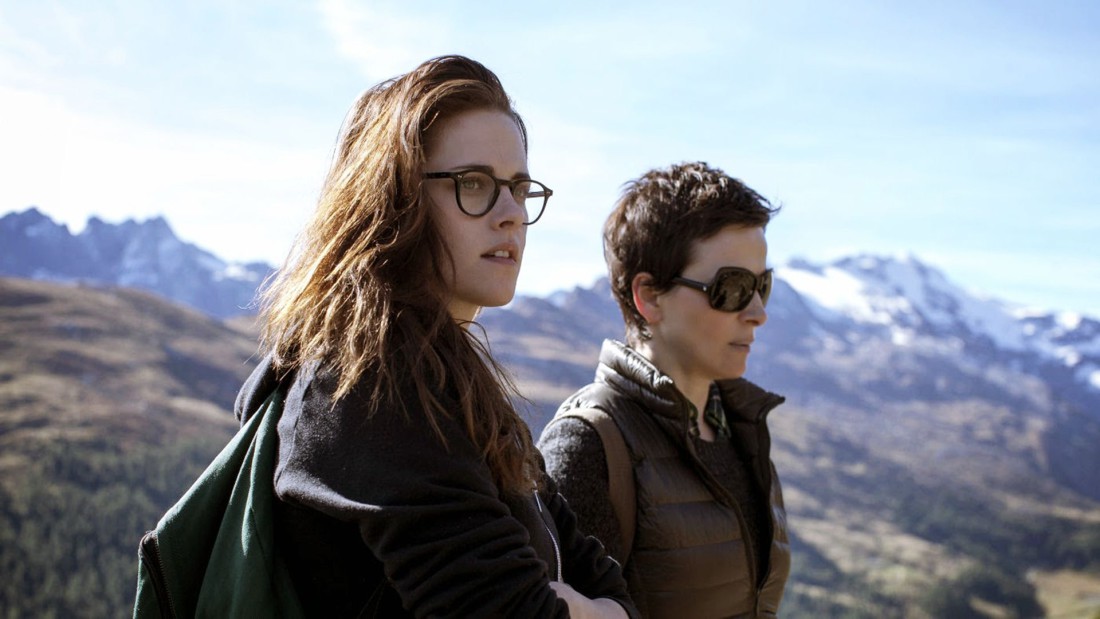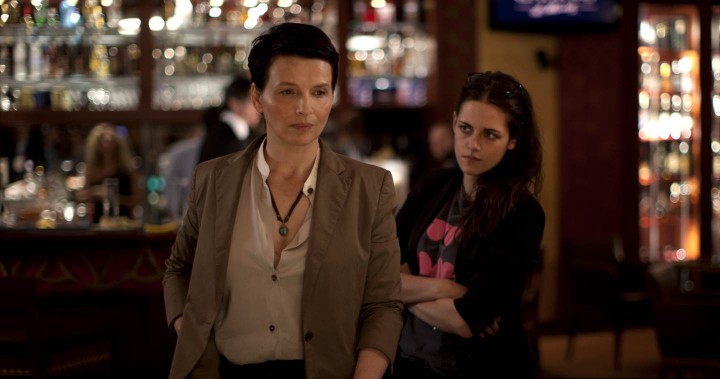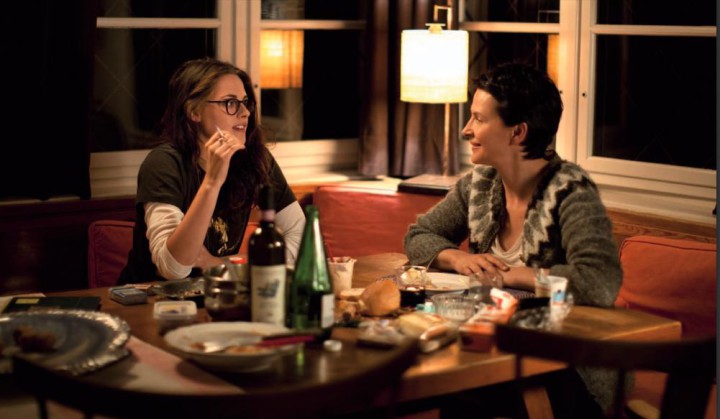It is rare — once a year would be lucky — that we get a film as densely yet delicately layered as Olivier Assayas’ Clouds of Sils Maria. The thing you’ve probably heard about the film — if you’ve heard anything — is that Kristen Stewart won the Best Supporting Actress César (essentially the French Oscar) for her performance in the film (making her the first American to do so). While that is certainly a notable — and deserved — accolade, it is hardly the only noteworthy aspect of this fine film, which might best be described as a more cosmopolitan take on an Ingmar Bergman chamber drama — and more. It’s a backstage story, a movie about movies, a movie about identity, about fame, about aging, about death — all done in a gracefully unhurried, even poetic, yet very savvy and tense manner.
Not being as familiar as I might be with Assayas’ work, I was surprised to look back at my 2009 review for his Summer Hours and find that — with minimal tweaking — I could easily drop large chunks of that review into this one. For example: “Assayas plays his cards close to his chest — rarely commenting, never stressing his points, just letting the viewer take in the quiet enormity of what’s really going on beneath a story that can be reduced to one simple concept: disposing of a large estate and the collectibles it holds. But there’s a lot more going on beneath the surface of that simple concept.” Change the simple concept to “preparing for a play,” and it works. While this — “On its most basic level, the film is a kind of ‘end of an era’ drama — the kind of emotionally charged work that makes one long to hold onto something that will soon be no more” — doesn’t even need any alteration. There are more examples, but those will serve to illustrate that these are works by a genuine artist with a coherent vision.
The film stars Juliette Binoche as Maria Enders, a famous movie star who — through a series of unexpected events — agrees to star in a new staging of the play, Maloja Snake, that started her career. But there’s a key difference to this production — Maria will not be playing the role she did 20 years ago. Rather, she’ll be playing the role of the older woman her original character seduced and destroyed. Her original role will be played by tabloid-fodder movie star (from some YA sci-fi series) Jo-Ann Ellis (Chloë Grace Moretz). Maria is uneasy about the whole thing. Her co-star 20 years ago — in the role she’ll now play — died in a car crash a year later, she’s not sold on this Ellis girl, and, as much as anything, it’s an admission of her own aging. But since she’s agreed, she retires to the house of the play’s late author near Sils Maria in the Swiss Alps to rehearse the play — and learn the new part — with the aid of her much put-upon (but seemingly unflappable) personal assistant, Valentine (Stewart). These rehearsals and what they reveal — or suggest — about Maria and Valentine are the centerpiece of the film, with much conveyed by the fact that it becomes increasingly hard to tell where the rehearsals stop and actual conversation begins. Brimming with subtext — that might nearly be text — it’s a fascinating portrait of the two and the growing impossibility of their relationship.
There’s more to it than that, since the film shrewdly deconstructs Stewart’s perceived public persona — never more pointedly than in a scene where Valentine mines Jo-Ann Ellis’ atrocious sci-fi flick for deeper meanings. (For that matter, there’s a direct Twilight joke when Valentine synopsizes a bad screenplay being offered to Maria, adding, “There are werewolves involved for whatever reason.”) But then there’s also the character of Jo-Ann herself, who seems to genuinely admire Maria (or is there a trace of All About Eve‘s Eve Harrington in this?), but who also manages to live up to her tabloid image. And just as everything seems grimly clear, Assayas introduces a character to put a somewhat different spin on things. It doesn’t end there — this is too rich a film to discuss fully in this space. Do yourself a favor and catch this one. Rated R for language and brief graphic nudity.








A Brady Corbet cameo in yet another quality film.
Wrong.
…in terms of the other one being quality, that is. This one qualifies, though.
Who the hell is Brady Corbet and why should I care?
He will be a household name soon enough you’ll see.
In your household? That I don’t doubt.
And who exactly is he in Clouds of Sils Maria?
Chlöe’s boy toy.
That’s more of a bit part than a cameo. A cameo is more like Oliver Reed as a train conductor in Mahler or Daniel Bruhl as the “The Oak Fairy” in 2 Days in New York,, i.e., people popping up on the basis that the audience will get the joke.
He’s the other director that meets with her at the end of the movie.
Well, I guess that shows what kind of impact both performances had on me…
The performance is fine, but I didn’t know who this burgeoning household name was. I still really don’t — except he’s the guy at the end of the movie who rejects his own generation’s values.
I need to see Irma Vep.
Well, it’s out of stock on Amazon.
Is it on Netflix as a DVD? Do you think I would like Clouds of Sils Maria a little more if I had seen Irma Vep?
Since I haven’t seen Irma Vep, I don’t very well see how I can answer that.
That said, my copy has been shipped.
Alright, Chris, I’ve watched Irma Vep. I think I like it, but it’s very different from anything else of Assayas’ work that I’ve seen. And there are aspects of it that left me more puzzled than anything. Before you tackle it…have you ever seen Les Vampires (1915)? How familiar are you with the trajectory of the New Wave in general? With Godard in particular?
I finally caught this and I have to say I’m pretty enamored with it, though not I’m entirely sure I can competently say why. This seems to me the epitome of that kind of movie that’s impossible to really discuss with any clarity after just one viewing; it almost seems designed to require multiple watches in order to really grasp the really particular ways that it moves and evolves over its length. But even taking it at a fairly surface level, this is just a fascinating and pretty honest examination of creative and critical processes, of the relationship that art has with the people who create and consume it, of identity and the contradiction of its stasis and its malleability. Or at least that’s what I got from it the first time around.
For some reason I feel like this would pair really well with VENUS IN FUR.
I’d sat that’s pretty good for one viewing. I think I’d seen it three times when I wrote the review — at least twice.
I can see it paired with Venus in Fur.